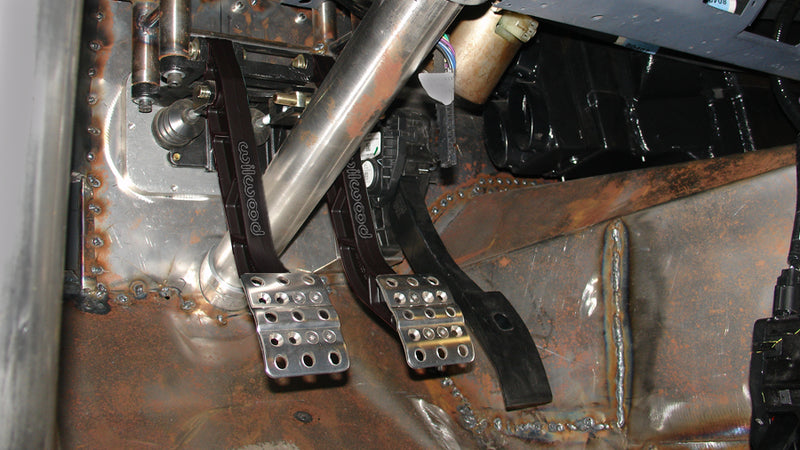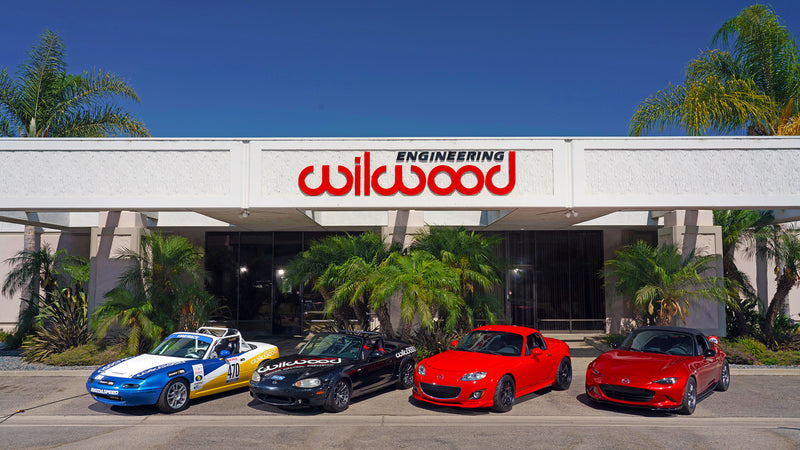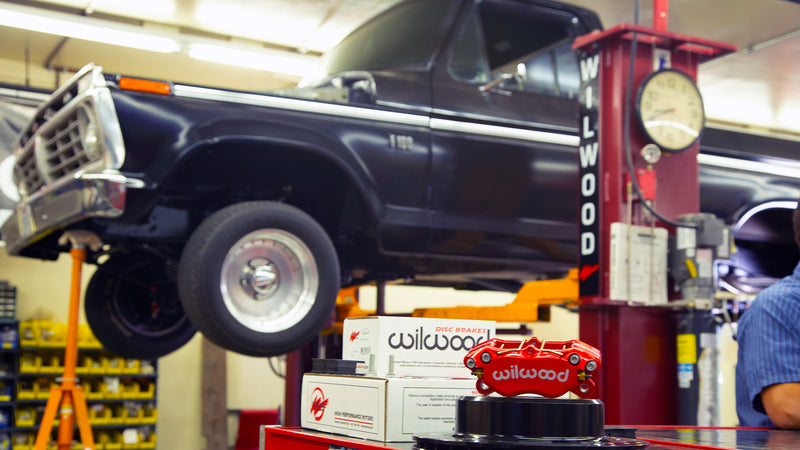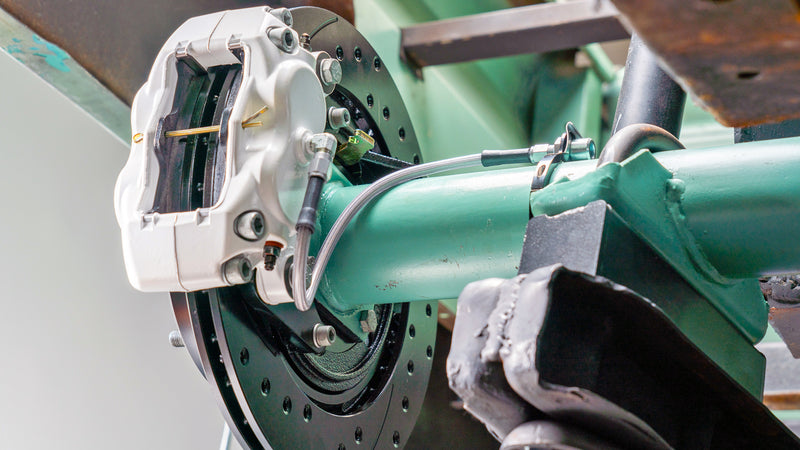
Decades ago, four-wheel drum brakes were standard, power-assisted brakes were an extra-cost option, and depending on how old your project vehicle is, disc brakes may not have even been offered. These days, most new cars and trucks come standard with power disc brakes, even the lowest priced examples. Wilwood does not make vacuum boosters or hydro-boost units, but we do make master cylinders that work with factory or aftermarket power brake units. In the racing world, where our brakes first gained fame, drivers prefer the more granular feedback and control of unboosted, manual brakes.
Because of this, we are experts in making manual brake systems work well. Of vital importance when planning a manual brake system is getting the pedal ratio correct. The pedal ratio is the relation between the pedal pivot, the master cylinder push rod, and the footpad your foot presses. Manual brakes don't require colossal leg strength to deliver high-performance braking and won't wear out your leg after a few hours of driving, as long as they have the correct pedal ratio.
Pedal Ratio

The hardest part of finding the pedal ratio on a car is usually measuring under the dashboard. Luckily, since you only need a rough measure for the ratio, there is no need for a micrometer or a set of calipers. A tape measure, your eyeballs, and a notepad are more than good enough. Typical non-boosted ratios range from 6:1 to 7:1, with booster pedals using 4.5:1 to 5:1.
The pedal ratio is simply the distance from the center of the pedal pivot point to the middle of the footpad (A), divided by the distance from the pedal pivot to the master cylinder pushrod (or the hole it attaches to) (B). On these diagrams covering the four different configurations of brake pedals, F is always the footpad, and P is the pivot. If you measure 12-inches from pivot to center of the pad and 2-inches pivot to push rod, that is a 6:1 ratio. For reverse-mounted master cylinders, the pivot is between the pushrod and the footpad, but the math is the same. No matter which type of pivot and pedal relationship your car uses, the math for figuring the ratio is the same (unless there is a bell crank involved).
As measurement A increases, or B decreases, the brake force into the master cylinder will increase without additional effort at the pedal. However, the pedal travel will increase as well.
Back when power brakes were just an option, the factory would have different pedals, or different mounting holes, or other ways to provide two different ratios. If you are restoring or resto-modding an old car and finding the brakes seem to take a lot of leg muscle, you may have mismatched a power brake ratio pedal with non-power brakes. Fixing it requires moving the pivot or master cylinder pushrod. But be careful, because the pushrod needs to have a straight shot (off by less than a few degrees) into the master cylinder to work correctly.

The factories have used various methods to accommodate manual and power brakes with as few changes as possible. A bell crank linkage is found in the bracket between the booster and firewall on some post-WWII cars. A lever with the booster connected to the end and the pedal connected in the center decreases the ratio and, therefore, pushrod travel.
Many 1960s and 1970s cars from GM and others mounted the power booster at a slight angle, aiming the pushrod at a hole lower in the pedal arm for a lower ratio. Power-assisted brakes can make do with ratios of 4.5:1 or lower, which on a 12-inch long pedal would put the pushrod about 2 5/8-inch from the pivot.

Wilwood's pedal assemblies are designed strictly for manual brake cars (though our master cylinders work for either) and are primarily intended for dedicated race vehicles. Ratios available include 5.1:1, 6:1, 7:1, and 10:1 for various types of racing.
The Wilwood 10:1 pedal is designed for off-road race vehicles using non-boosted brakes with large piston area calipers. The rough terrain often causes brake pad knock-back, and a large-bore master cylinder pumping greater fluid volume moves the caliper pistons back into place quickly. Unfortunately, this necessitates a big pedal ratio to produce good line pressure without power brakes or a tremendous amount of leg effort.
With the proper brake pedal leverage ratio, adequately sized master cylinder bore, and the right Wilwood brakes at each wheel, you should be able to race all day without getting a sore leg.




1964 FALCON GASSER FRONT AND REAR DYNALITE CALIPERS WHAT MASTER CYLINGER AND PEDAL RATIO DO I NEED
Aaron,
The typical pedal ratio for a manual brake car is 6:1 – if you are 5.9:1 you should be fine.
The 15/16” master cylinder are what we recommend for out four piston Dynalite or Dynapro calipers on the front of a Falcon, with a 6:1 pedal.
Bryan
Hi guys, I have four wheel Wilwood 320mm discs, and 4 piston callipers, Wilwood 15/16ths black master cylinder. What is the ideal pedal ratio? It’s a 1967 Falcon. It’s currently 5.9
Chris,
Doing an internet search, it appears that some ‘Cudas used an 8” or 9” booster mounted to a bracket that moved it up with a bell crank to lower the pedal ratio. While others used a larger diameter booster, and a linkage under the dash to get the same effect.
Either way, I am only seeing one length brake pedal arm online with one pushrod hole for both manual and power. Just to be sure, when you are ready to order, look under the dash and measure the pedal ratio to confirm it.
I think your car is one of the Mopars that used the 4-bolt mounting flange we specifically made the Mopar compact tandem master cylinder for (https://www.wilwood.com/PDF/Flyers/fl524.pdf).
You are probably correct about the cam not allowing the engine to produce enough vacuum for power brakes.
I have a 1970 Plymouth ‘Cuda with original power brakes with front factory disc. These brakes never worked well so I removed the power unit, proportioning valve and master cylinder. I believe this was from little engine vacuum from the camshaft grind. I then put a master cylinder for non power brakes along with a proportioning valve. I then had to modify the rod from the pedal to the master. I now want to upgrade with your Wilwood front discs and want to replace the master, proportioning valve, and the brake pedal rod. I don’t trust these parts as I did this 40+ years ago. Is my pedal ratio “off” going from a power to non power? and I’d like to have a master with the correct rod attached with a new clip for the rod to pedal. I will call your techs when I’m ready to purchase. I want this to be safe and eliminate the jury-rig I did long ago.
Sam,
Every car is going to be different, but the best place to start would be with the pedal ratio that Chevy used on the vacuum assist power brake cars. That was likely 4-4.5 to 1.
On the Corvette they did this by having 2 holes in the pedal arm, and mounting the power brake master cylinder and booster an inch or so lower on the firewall. The power brake master cylinder uses a 1.125” (1-1/8”) bore as well, compared to the 1” on the manual brake car.
Looking at the vacuum booster that came on the 1967 Impala, they angled the master cylinder to hit a lower hole in the brake pedal. However, the early cars like your 65, appear to use a bell crank setup like the 1959-64 cars.
You are going to want to either angle the booster or use a bell crank. If you have room, you can move the mounting studs and lower where the hydroboost is in relation to the pedal pivot. A quick look online shows the 67 and up cars had pedal arms with two holes in them.
Bryan Wood
If I understand this, then going from manual brakes to hydro boost will result in overly touchy brakes if I don’t lower my pedal ratio.
The project is a 65 impala with C3 Corvette brakes from Master cylinder to all four corners, with hydro boost. Since the cars have different weight distribution, I’m including 260-11179 proportioning valve.
I’m building a Lotus 7 type car, which will be about 1400-1500 lbs car without brake booster.
Which brake master cylinder and clutch cylinder do you recommend for me. The car will be used on street only.
I am rebuilding old VW trike with master cylinder 260-2636 5/8 bore with the old-style brake drums and it all most has to go a full stroke before the brake catches.
I am also running master cylinder 260-1304 3/4 bore for the slave cylinder and it has to move a 1/3 of the stroke before it starts to move the slave cylinder, does not compress the clutch all the way before full stroke.
I have blead all the air out the system, but master cylinder is not level and I’m not sure if that makes a difference.
Rob,
If I am reading your comment correctly, your math is accurate. I also get 7.65” and change for the pedal travel. To keep from bending anything or wearing the master cylinder internally, you should have some sort of stop on the pedal to keep it from bottoming out the piston in the master cylinder. If the pedal hits the floor at 7.65” of travel, that ought to be a sufficient stop. But make sure it hits the floor before it bottoms out.
Remember, 100 lbs of force from your leg is going to result in 683.333 lbs of force into the pushrod, piston, and mounts for the master cylinder (if it ever bottoms out). If everything is working properly, the hydraulic resistance in the system will keep you from ever using the full travel.
I’ve installed MC 10374 (single 7/8"). I’ve measured the distance from the center of the pedal to the pivot as 10.25" and the MC push rod to the pivot as 1.5", giving the ratio as 6.833333. My set up has the PC push rod connected above the pivot and the pedal is below the pivot. The documentation mentions the stroke as 1.12". Therefore, is it correct to assume that the pedal should travel 7.65" when fully depressed?
Jason,
For use with a power brake booster:
1. Verify vacuum requirement: 18” of manifold vacuum at idle(use a gauge on the hose going to the booster).
2. Either the OE size booster (usually 9” and larger) or a dual diaphragm 8” booster; nothing smaller.
3. Power brake pedal ratio, 3.75-5:1, but most are pretty close to 4:1
4. If caliper piston area is larger than 5.40”(D8 and D52) use a 1.12” bore. For 5.4-4.04”(Nearly everything else), use a 1” bore.
The 6-piston Superlite front kit we catalog for a 1992 Camaro has 4.04 square inches of piston area. The rear brakes will have plenty of fluid volume and pressure with that size as well.
If you using manual brakes, or a balance bar and two individual master cylinders, it gets much more complicated, but it will definitely require a smaller bore. Please call our tech line at (805) 388-1188 during normal business hours and we will be happy to do the math based on what you are using the car for and the brake kits you mentioned.
I have a 92 camaro, which I will be running your 6 piston calipers in the front with the 14" Rotor. Rear will be a 4 piston with the 12.88 Rotor. What master cylinder set up do you recommend?
I did a complete Wilwood brake upgrade to my 1970 Chevelle SS (new master, new booster, new front disks, rear disk conversion, lines, prop valve, etc…) but no matter how much I adjust my prop valve, the car just doesn’t want to stop. I press the pedal as hard as I can and it’s like pushing against a wall with little stopping power. Rear brakes: 140-14259, Front brakes: 140-11290, Front Booster: 11", Master Cyl: 261-13270P 1.125" bore with prop valve. There are no leaks in the system and the system was bled using a vacuum compressor bleeding system.
I just don’t know why it’s not working and barely stops with full pedal pressure. As stated, pushing the pedal is like pushing a wall with little braking power provided. Any ideas? Any help would be sincerely appreciated!
Dan,
While I am not certain the Wilwood master cylinder will bolt up to the Thunderbird booster, the shorter stroke should not be a problem. You want the limiting factor of the brake stroke to be in the pedal or booster and not the piston bottoming out in the master cylinder. 1.1 inch is the maximum travel the piston can make before bottoming. If the Wilwood master cylinder that is the same size bore as the factory one there will be no need for it to travel any further than the factory unit.
The pushrod from the booster should go straight and level into the master cylinder piston. It appears the mounting studs for the Thunderbird M/C may be slightly above the center of the center hole in the booster which will be an issue.
Unfortunately we do not make power brake boosters.
I am trying to install a new wildwood master cylinder in my 1960 thunderbird. The bird has power brakes with a stroke of about 3/4 inch. The Wilwood master cylinder instructions say it uses 1.1 inch stroke. The master cylinder is part 260-8555. Do I need to get a different master cylinder?Is this adjustable? Do you sell a booster that would work? Recommendations? Thanks Dan phone 913-269-0676
Kenneth,
We will need a few more pieces of information in order to get you exactly the right size master cylinder bore. One of those is what Wilwood kit you want to put on the front of the car, and what wheel/tire sizes do you plan on using, and what is the intended purpose of the car (Weekend cruiser? Street/strip? Autocross? Track days?). I can tell you the stock Chevrolet master cylinder with the manual disc brakes was a 1" bore. Moving down to a 15/16" or even a 7/8" might be recommended if you 1) Want to be able to stop with less pedal effort, or 2) are installing a Wilwood kit with significantly less piston area that the factory calipers.
1968 Camaro w/ vacuum brakes. I’m wanting to convert to manual brakes with wilwood disk brakes in the front and for now leave the drum brakes and convert to disk later.
What master cylinder do you suggest.